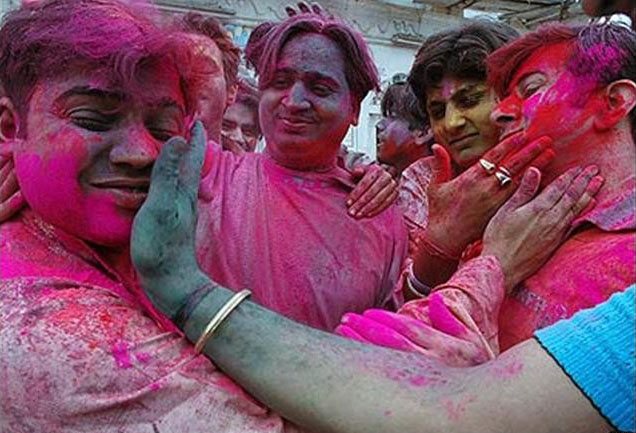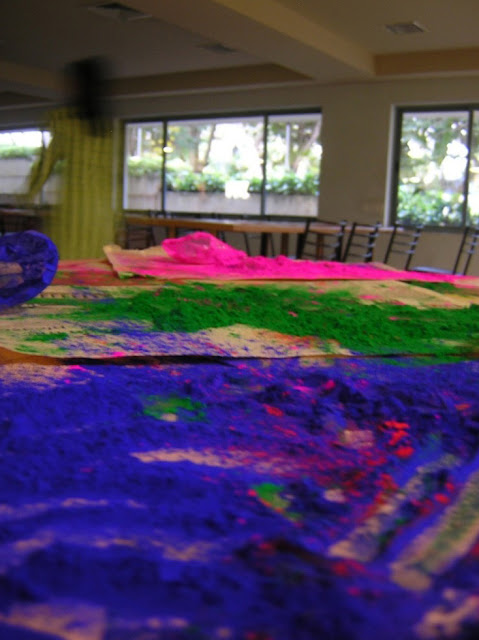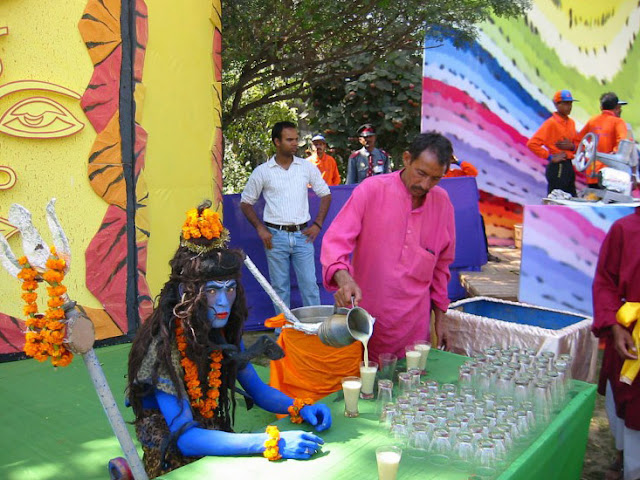 Festival is known as the "Festival of Color" and is a celebration of Lord Krishna and God's Creations. The colorful festival of Holi, literally means 'burning', is celebrated on the full moon day in the month of Phalguna and heralds the onset of spring season. Holi is the time when people from all castes and social strata come together forgetting all past differences and grievances.
Festival is known as the "Festival of Color" and is a celebration of Lord Krishna and God's Creations. The colorful festival of Holi, literally means 'burning', is celebrated on the full moon day in the month of Phalguna and heralds the onset of spring season. Holi is the time when people from all castes and social strata come together forgetting all past differences and grievances.Originally the festival was primarily for the Shudras who were otherwise not allowed to participate in festivals. This is specially significant in the rural areas where in many places, there still exists a clear demarcation between each caste and community.
The main ritual on this day centres around a bonfire ceremoniously kindled at the time of the rising moon. This suggests that the festival is also a celebration of the barley harvest. People start collecting fire - wood, cow-dung and rubbish around a central pole in their locality many days in advance. On Choti Holi, they come together to light the fire. Men and women circumambulate the fire singing and dancing. A pot of new barley seeds is buried under the pyre for roasting. These seeds are eaten after the fire is extinguished . Divinations for the coming harvest are cast by interpreting the direction of the flames or by the state of the seeds in the buried pot. People sometimes take embers from the fire to their homes to rekindle their own domestic fires. The ashes from the Holi fire are also believed to provide protection against diseases.
The next day is called 'Dhulendi' and it is during these celeberations that people throw colored powder or 'gulal' and colored water on each other using 'pichkaris' shouting 'bura na mano holi hai'. The origin of this custom can be found in the pranks of Krishna, who used to drench the village belles or "gopis" with water and play tricks on them. 'Thandai', a drink made with almonds and milk, and cannabis 'bhang' pakoras are extremely popular on this day. A typical sweet meat served on this day is 'gujhia' and 'kanji vadas' are a popular appetiser.
Holi at Mathura and Vrindavana is celebrated with great gusto for many days, as these were the places where Krishna spent most of his childhood. Each major temple celebrates Holi in a different day. People throng the temples to get drenched with colored water and consider it a blessing from the god. Of particular interest is the Holi festival in the village of Barsana, 42 km from Mathura. Radha belonged to Barsana while Krishna hailed from Nandagaon. On Holi, men from Nandagaon come to Barsana to celebrate Holi with the women here, who are ready to beat them with sticks instead of playing with 'gulal'. This is called "lathamar Holi". This is very similar to the "Dhulendi Holi" played in Haryana, where the "bhabhi" (sister-in-law) beats her "devar" (younger brother-in-law) with her sari rolled up into a rope. All this is done in good humor and in the evening the devar brings sweetmeats for his bhabhi.
Holi though is not very popular in South India, but a similar festival in the honor of the god of love Kama, takes place there at the same time. While there does not seem to be a direct link between the two rituals, literary sources suggest that both occasions are examples of an age-old tradition of celebrating the arrival of spring.
In Maharashtra and Gujarat, a grand procession of men soaked with colored water walk through the streets shouting 'Govinda alha re alha, zara matki sambhal brijbala''. This refers to Krishna's habit of stealing butter and milk stored in terracotta pots from people's homes. As a child, Krishna who was extremely fond of milk and milk products would prowl into any accessible house with his friends and steal pots of butter or break pots of milk. During Holi, a pot of buttermilk is hung high up in the street. Men forming a human staircase try to break this pot, and whoever succeeds is crowned the Holi king of the locality for that year.
In Bengal, Holi is called Dol Yatra, or the swing festival. Idols of Radha and Krishna are placed on swings and devotees take turns to swing them. Women dance around the swing and sing devotional songs, as men spray colored water at them. In Manipur too, Holi is extremely interesting. It is a six-day festival here, commencing on the full moon day of Phalguna. The traditional and centuries-old Yaosang festival of Manipur amalgamated with Holi in the18th century with the introduction of Vaishnavism. The entire theme of the festival is woven into the worship of Krishna and Chaitanya Mahaprabhu, also known as Lord Gauranga.
Thabal Chongba, a popular Manipuri folk dance, is associated with this festival. The literal meaning of Thabal is 'moonlight' and Chongba means 'dance', thus 'dancing in the moonlight'. Traditionally conservative Manipuri parents did not allow their daughters to go out and meet any young men without their consent. Thabal Chongba therefore provided the only chance for girls to meet and talk to the boys. In earlier times, this dance was performed in the moonlight accompanied by folk songs. The only musical instrument used was a dholakor drum. It is performed in every locality on all the six days of the festival. Instead of a fire, a hut is built and then set ablaze. The next day, boys go in groups to play gulal with the girls. And in return for playing with them, the girls extract money from the boys.
Another significant feature of the festival in Manipur is the groups of devotees from different areas who gather at the Shree Govindaji Temple in Imphal. Dressed in the traditional white and yellow turbans, they sing songs in praise of Krishna and Chaitanya Mahaprabhu, play gulal and dance in front of the temple. On Halangkar, the last day of the festival, hundreds of devotees gather at the temple as usual and march together towards the Vijay Govindaji Temple about 3 km west of Imphal where various cultural activities are performed. This brings to an end the Yaosang festival.


































No comments:
Post a Comment